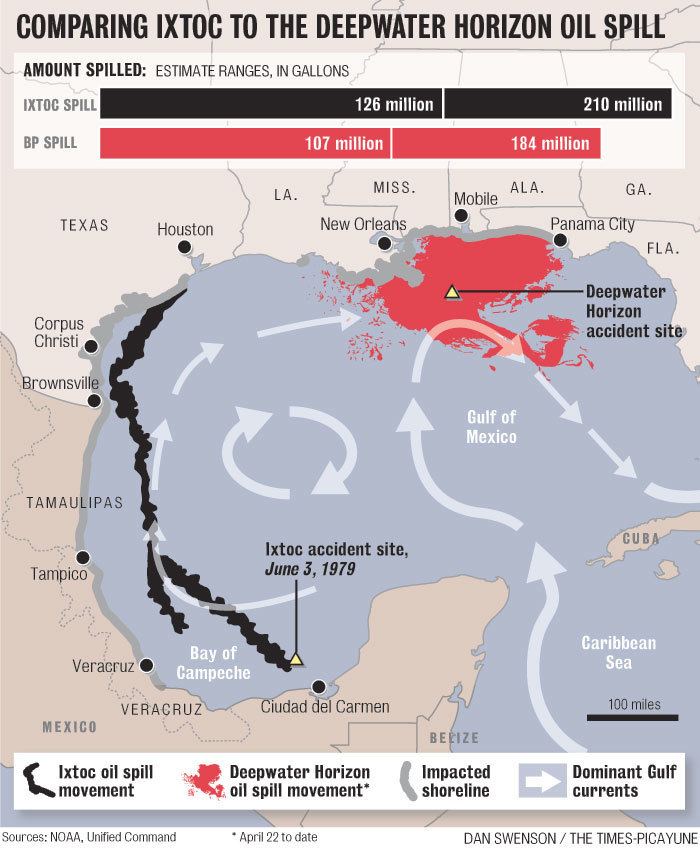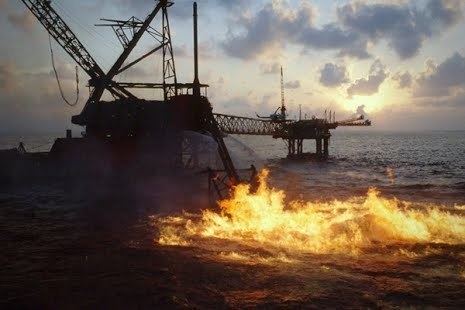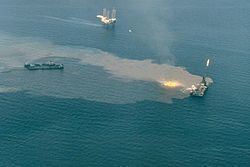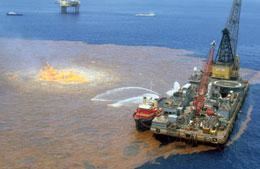Area 2,800 km² | Shoreline impacted 261 km (162 mi) Start date June 3, 1979 | |
 | ||
Volume 3 million barrels (130,000,000 U.S. gallons; 480,000 cubic meters) Similar Exxon Valdez oil spill, Gulf War oil spill, Deepwater Horizon oil spill, Deepwater Horizon explosion, Castillo de Bellver oil spill | ||
Ixtoc i oil spill gulf of mexico1979
Ixtoc I was an exploratory oil well being drilled by the semi-submersible drilling rig Sedco 135-F in the Bay of Campeche of the Gulf of Mexico, about 100 km (62 mi) northwest of Ciudad del Carmen, Campeche in waters 50 m (160 ft) deep. On 3 June 1979, the well suffered a blowout resulting in one of the largest oil spills in history.
Contents
- Ixtoc i oil spill gulf of mexico1979
- Accident
- Volume and extent of spill
- Containment
- Aftermath
- Long term effects
- References

Accident

Mexico's state-owned oil company Pemex (Petróleos Mexicanos) was drilling a 3 km (1.9 mi) deep oil well when the drilling rig Sedco 135F lost drilling mud circulation.

In modern rotary drilling, mud is circulated down the drill pipe and back up the well bore to the surface. The goal is to equalize the pressure through the shaft and to monitor the returning mud for gas. Without the counter-pressure provided by the circulating mud, the pressure in the formation allowed oil to fill the well column, blowing out the well. The oil caught fire, and Sedco 135F burned and collapsed into the sea.

At the time of the accident Sedco 135F was drilling at a depth of about 3,600 metres (11,800 ft) below the seafloor. The day before Ixtoc suffered the blowout and resulting fire that caused her to sink, the drill bit hit a region of soft strata. Subsequently, the circulation of drilling mud was lost resulting in a loss of hydrostatic pressure. Rather than returning to the surface, the drilling mud was escaping into fractures that had formed in the rock at the bottom of the hole. Pemex officials decided to remove the bit, run the drill pipe back into the hole and pump materials down this open-ended drill pipe in an effort to seal off the fractures that were causing the loss of circulation.

During the removal of the pipe on Sedco 135F, the drilling mud suddenly began to flow up towards the surface; by removing the drill-string the well was swabbed leading to a kick. Normally, this flow can be stopped by activating shear rams contained in the blowout preventer (BOP). These rams are designed to sever and seal off the well on the ocean floor; however in this case the drill collars had been brought in line with the BOP and the BOP rams were not able to sever the thick steel walls of the drill collars leading to a catastrophic blowout.

The drilling mud was followed by a large quantity of oil and gas at an increasing flow rate. The oil and gas fumes exploded on contact with the operating pump motors, starting a fire which led to the collapse of the Sedco 135F drilling tower. The collapse caused damage to underlying well structures. The damage to the well structures led to the release of significant quantities of oil into the Gulf.
Volume and extent of spill
In the initial stages of the spill, an estimated 30,000 barrels (5,000 m3) of oil per day were flowing from the well. In July 1979, the pumping of mud into the well reduced the flow to 20,000 barrels (3,000 m3) per day, and early in August the pumping of nearly 100,000 steel, iron, and lead balls into the well reduced the flow to 10,000 barrels (2,000 m3) per day. Pemex claimed that half of the released oil burned when it reached the surface, a third of it evaporated, and the rest was contained or dispersed. Mexican authorities also drilled two relief wells into the main well to lower the pressure of the blowout, however the oil continued to flow for three months following the completion of the first relief well.
Pemex contracted Conair Aviation to spray the chemical dispersant Corexit 9527 on the oil. A total of 493 aerial missions were flown, treating 1,100 square miles (2,800 km2) of oil slick. Dispersants were not used in the U.S. area of the spill because of the dispersant's inability to treat weathered oil. Eventually the on-scene coordinator (OSC) requested that Mexico stop using dispersants north of 25°N.
In Texas, an emphasis was placed on coastal countermeasures protecting the bays and lagoons formed by the barrier islands. Impacts of oil to the barrier island beaches were ranked as second in importance to protecting inlets to the bays and lagoons. This was done with the placement of skimmers and booms. Efforts were concentrated on the Brazos-Santiago Pass, Port Mansfield Channel, Aransas Pass, and Cedar Bayou which during the course of the spill was sealed with sand. Economically and environmentally sensitive barrier island beaches were cleaned daily. Laborers used rakes and shovels to clean beaches rather than heavier equipment which removed too much sand. Ultimately, 71,500 barrels (11,000 m3) of oil impacted 162 miles (260 km) of U.S. beaches, and over 10,000 cubic yards (8,000 m3) of oiled material were removed.
Containment
In the next nine months, experts and divers including Red Adair were brought in to contain and cap the oil well. An average of approximately 10,000 to 30,000 barrels (2,000 to 5,000 m3) per day were discharged into the Gulf until it was finally capped on 23 March 1980, nearly 10 months later. In similarity to the Deepwater Horizon oil spill 31 years later, the list of methods attempted to remediate the leak included lowering a cap over the well, plugging the leak with mud and "junk", use of dispersants, and spending months attempting to drill relief wells.
Aftermath
Prevailing currents carried the oil towards the Texas coastline. The US government had two months to prepare booms to protect major inlets. Pemex spent $100 million to clean up the spill and avoided most compensation claims by asserting sovereign immunity as a state-run company.
The oil slick surrounded Rancho Nuevo, in the Mexican state of Tamaulipas, which is one of the few nesting sites for Kemp's Ridley sea turtles. Thousands of baby sea turtles were airlifted to a clean portion of the Gulf of Mexico to help save the rare species.
Long-term effects
The oil that was lost during the blow-out polluted a considerable part of the offshore region in the Gulf of Mexico as well as much of the coastal zone, which consists primarily of sandy beaches and barrier islands often enclosing extensive shallow lagoons.
The oil on Mexican beaches that the authors observed in early September was calculated to be about 6000 metric tons. Based on reports from various groups and individuals, five times that figure is thought to represent a fair estimate of what had landed on Mexican beaches. Investigations along the Texas coast show that approximately 4000 metric tons of oil or less than 1 percent was deposited there. The rest of the oil, about 120,000 metric tons or 25 percent, sank to the bottom of the Gulf.
The oil had a severe impact on the littoral crab and mollusk fauna of the beaches which were contaminated. The populations of crabs, e.g. the ghost crab Ocypode quadrata, were almost totally eliminated over a wide area. The crab populations on coral islands along the coast were also reduced to only a few percent of normal about nine months after the spill.
One study found that the most persistent issues were pollution of estuaries and coastal lagoons lining the bay, and especially the effects on breeding and growth of several food fish species.
The oil washed ashore, 30 cm (1 ft.) deep in some places, as it was pushed north by prevailing winds and currents until it crossed the Texas border two months later and eventually coated almost 170 miles (270 km) of US beaches. The beach that caused most international concern in Mexico was Rancho Nuevo, a key nesting ground for critically endangered Kemp's Ridley sea turtles which had already moved inland in their hundreds to lay eggs. By the time the eggs hatched, the oil had reached the shore.
Fishing was banned or restricted by Mexican authorities in contaminated areas north and south of the well. Fish and octopus catches dropped by 50 to 70% from the 1978 levels. Some larger species with longer life spans took years to recover from the Ixtoc spill. It wasn't until the late-1980s that the population of Kemp's Ridley turtles, which lay a couple of hundred eggs a year, as opposed to the millions produced by shrimp, started recovering. The immediate losses from an oil spill continue to affect larger species for generations.
There is much less information on the impact of the Ixtoc I spill on benthic species (bottom dwellers). The best studies were on the Texas coast over 1000 km from the spill. Massive kills can occur when oil reaches the benthos in sufficient quantity. The only indication of a massive kill may be the remains of the dead organisms, but if they lack hard parts there will be little evidence.
A report prepared for the US Bureau of Land Management concluded with respect to the spill's effect on US waters:
In spite of a massive intrusion of petroleum hydrocarbon pollutants from the Ixtoc I event into the study region of the South Texas Outer Continental Shelf during 1979-1980, no definitive damage can be associated with this or other known spillage events (e .g ., Burmah Agate ) on either the epibenthic commercial shrimp population (based on chemical evidence) or the benthic infaunal community. Such conclusions have no bearing on intertidal or littoral communities, which were not the subject of this study.
